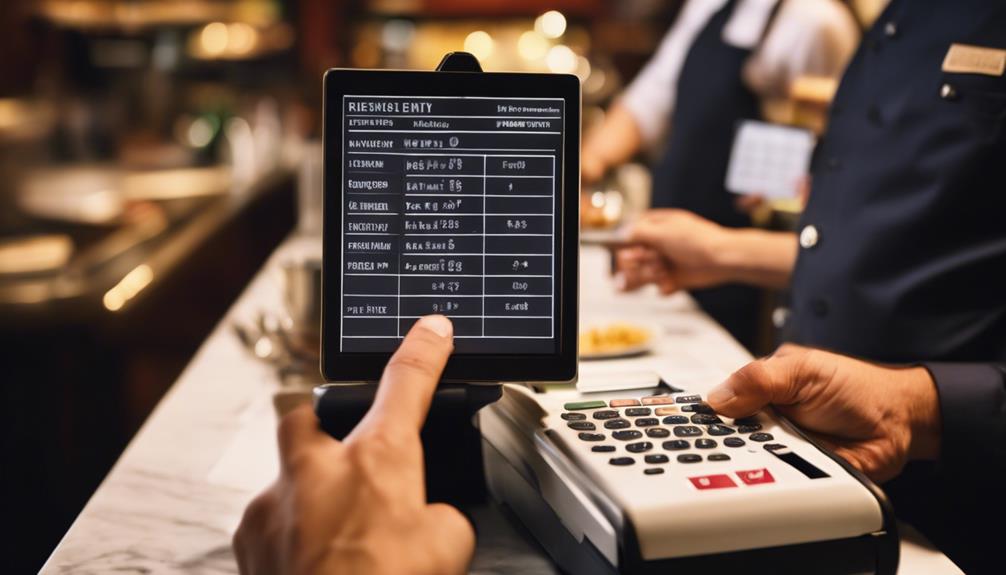Optimize menu data entry with templates for consistency. Standardize formats and sections for items, descriptions, prices, and categories. Batch entry saves time and ensures accuracy. Automate inputs with validation, POS integration, software, and barcode scanning. Train staff on efficient entry and error correction. Streamline updates with a centralized system and standardized procedures. Double-check for accuracy, using spell-check and review processes. Monitor workflow to eliminate bottlenecks and errors. Master these practices for efficient menu data entry to enhance operations.
Utilize Templates for Consistency
To maintain uniformity and streamline the data entry process, consider utilizing templates designed specifically for restaurant menus. Standardize formatting by using templates that have predetermined sections for menu items, descriptions, prices, and categories. This consistency ensures that all menu items are entered in a structured manner, making it easier to navigate and update the menu database.
By using templates, you improve efficiency as data entry becomes more straightforward and less time-consuming. Templates also reduce the chances of errors since they guide you on where to input specific information. This systematic approach not only saves time but also enhances the overall accuracy of the menu data.
When selecting or creating templates, ensure they are user-friendly and catered to your restaurant’s specific needs. Customizable templates can further boost efficiency by allowing you to tailor them to match your menu style and layout. Remember, the goal is to simplify the data entry process while maintaining a high level of consistency and organization.
Implement Batch Entry Processes
Consider implementing batch entry processes to streamline and expedite the data input for your restaurant menu efficiently. By utilizing batch processing, you can input multiple menu items at once, saving time and reducing the likelihood of errors. Implementing data validation techniques within batch entry processes ensures that the information entered is accurate and complete. These techniques can include automated checks for missing or incorrect data, helping to maintain the integrity of your menu database.
Batch processing offers several advantages that contribute to efficiency benefits. It allows you to input large volumes of data quickly, reducing manual input time significantly. Error detection methods can be incorporated within batch processes to identify and rectify any inconsistencies or mistakes in the data before finalizing the entries. This helps in maintaining data accuracy and consistency across your restaurant menu.
Automate Data Inputs When Possible
When automating data inputs for your restaurant menu, prioritize efficiency by leveraging technology to streamline the process. Implementing data automation can significantly enhance your data entry efficiency and accuracy. Here are some key strategies to consider:
- Utilize Data Validation Processes: Incorporate automated checks to ensure that the data entered is accurate and meets specific criteria.
- Integrate Point-of-Sale Systems: Connect your menu data directly to your POS system to automate updates and eliminate manual entries.
- Explore Menu Management Software: Invest in specialized software that automates menu creation, updates, and pricing adjustments.
- Implement Barcode Scanning: Use barcode scanners to input data quickly and reduce human error.
- Leverage API Integrations: Integrate your menu data with other systems using APIs to automate data transfers and updates seamlessly.
Train Staff on Efficient Data Entry
To ensure efficient data entry at your restaurant, it’s crucial to train your staff effectively. By teaching them proper data entry techniques and emphasizing accuracy, you can streamline the process. Regularly monitoring data input accuracy will help maintain the quality of your menu information.
Staff Training Importance
Training your staff on efficient data entry techniques is crucial for maintaining accuracy and productivity in restaurant menu data entry. To ensure your team excels in this area, consider the following key points:
- Continuous Improvement: Encourage staff to seek ways to enhance their data entry skills continually.
- Ongoing Training: Provide regular sessions to update employees on the latest data entry practices.
- Error Correction Procedures: Teach staff how to identify and rectify data entry mistakes promptly.
- Keyboard Shortcuts: Familiarize employees with time-saving shortcuts for faster data input.
- Quality Control Checks: Implement protocols for verifying the accuracy of entered data to minimize errors.
Data Entry Techniques
Consider enhancing the efficiency of restaurant menu data entry by implementing advanced data input techniques among your staff. Train your team on data validation techniques to ensure accurate and consistent information entry. Utilize error prevention strategies such as dropdown menus, autofill options, and mandatory fields to reduce mistakes. Encourage staff to double-check entries before submission to catch any errors early on. Implement keyboard shortcuts and hotkeys to expedite data entry processes. Additionally, provide regular refresher training sessions to keep your team up to date with the latest data entry techniques. By focusing on these strategies, you can streamline menu data entry, minimize errors, and improve overall operational efficiency.
Monitoring Data Accuracy
Enhance the efficiency of restaurant menu data entry by ensuring your staff are well-trained in accurate and consistent data input techniques, particularly focusing on monitoring data accuracy. To achieve this effectively, consider the following:
- Implement Data Validation Procedures: Train your staff to double-check all entries for accuracy.
- Establish Quality Control Checks: Create a system where entries are reviewed by a second team member.
- Provide Ongoing Training: Keep your staff updated on the importance of accurate data entry.
- Utilize Technology: Invest in tools that can help automate data validation processes.
- Encourage Attention to Detail: Emphasize the significance of precision in data entry to maintain high-quality standards.
Streamline Menu Update Procedures
To optimize menu update procedures for efficiency and accuracy, establish a centralized system for managing all changes and revisions. This centralized system should include a designated individual or team responsible for overseeing menu revisions, ensuring data accuracy, and coordinating updates across all platforms consistently. Utilizing a centralized system helps streamline the process by keeping all menu data in one location, reducing the risk of errors that can occur when information is scattered across various documents or spreadsheets.
Implementing a standardized format for documenting menu changes can further enhance efficiency. Clearly outline the steps for updating menu items, prices, descriptions, and any other relevant information. By following a structured procedure, you can minimize confusion and errors during the update process. Additionally, consider using software or tools specifically designed for menu management to automate certain tasks and expedite the update process.
Regularly review and refine your menu update procedures to identify any bottlenecks or areas for improvement. Solicit feedback from staff involved in the process to pinpoint potential inefficiencies and address them promptly. By continuously optimizing your menu update procedures, you can ensure smooth operations and maintain data accuracy across all platforms.
Ensure Accuracy Through Double-Checks
Double-check for errors diligently to catch any inaccuracies that may have slipped through. Verify data accuracy by comparing entries against original sources or previous records. Implement review processes that involve multiple team members to ensure thoroughness and accuracy in menu data entry.
Double-Check for Errors
To ensure accurate data entry on restaurant menus, it is essential to implement a systematic process of verifying information through thorough double-checks. When it comes to double-checking for errors in menu data entry, consider the following:
- Cross-Verification: Compare the entered data against the original source to identify any disparities.
- Spell Check: Use spell-check tools to catch any typos or spelling errors that might have been overlooked.
- Numeric Accuracy: Verify all numerical data, such as prices and quantities, to ensure they are correctly entered.
- Consistency Check: Ensure that the formatting, such as font styles and sizes, is consistent throughout the menu.
- Menu Structure: Double-check the layout and organization of the menu items to guarantee a logical flow for customers.
Verify Data Accuracy
Compare the accuracy of data entries in your restaurant menu by conducting thorough double-checks to ensure precision and reliability. Implement data validation procedures to catch any discrepancies or inaccuracies that may have occurred during the data entry process. Accuracy verification is crucial to maintain the integrity of your menu information. Double-checking should involve verifying prices, ingredient lists, menu descriptions, and any other relevant details. By enforcing a strict double-check process, you can significantly reduce the likelihood of errors reaching your final menu. This attention to detail will not only enhance the overall quality of your menu but also prevent potential customer dissatisfaction due to inaccuracies. Take the time to verify data accuracy—it can make a substantial difference in the efficiency of your restaurant operations.
Implement Review Processes
To ensure the accuracy of your restaurant menu data entries, establish a systematic review process that includes meticulous checks for precision and consistency. Implementing review processes is crucial in maintaining data integrity. Here are five key steps to incorporate into your review process:
- Review approval: Assign designated reviewers to double-check all menu data entries.
- Template consistency: Ensure that the formatting and layout of the menu items are consistent throughout.
- Cross-referencing: Compare the data entered with the original source to catch any discrepancies.
- Spot check samples: Randomly select items for a thorough review to catch any overlooked errors.
- Regular audits: Conduct periodic audits to guarantee ongoing accuracy and consistency in your menu data entries.
Monitor and Improve Data Entry Workflow
For enhancing the efficiency of your restaurant menu data entry process, closely monitoring and continually refining the workflow is essential. To improve efficiency and data accuracy, start by mapping out the current data entry process. Identify bottlenecks or areas where errors commonly occur. Once you have a clear understanding of the workflow, streamline it by eliminating unnecessary steps and implementing automation where possible.
Regularly monitoring the data entry workflow allows you to detect inefficiencies promptly. Keep track of key performance indicators such as the time taken to input new menu items or the error rate in data entry. By analyzing this data, you can pinpoint areas that require improvement and implement targeted solutions.
Encourage open communication with your team to gather feedback on the data entry process. They may have valuable insights on how to enhance workflow efficiency. Additionally, consider providing training sessions to ensure that all staff members are proficient in data entry techniques. Continuous monitoring and improvement of the data entry workflow will lead to increased efficiency and higher data accuracy in your restaurant menu management.
Frequently Asked Questions
How Can Restaurant Menu Data Entry Processes Be Integrated With Inventory Management Systems for Better Efficiency?
Integrating restaurant menu data entry with inventory management boosts efficiency. Streamline processes for inventory optimization and cost control. Syncing menu changes with stock levels ensures accurate data. Automate alerts for low inventory to prevent shortages.
Are There Any Specific Software Tools Recommended for Automating Menu Data Input in Restaurants?
Looking to streamline menu data entry? Explore menu automation tools and software solutions for efficient data input. Boost productivity with user-friendly interfaces and customizable features. Overcome initial learning curves by leveraging intuitive support resources.
What Are Some Common Challenges Faced by Restaurants When Training Staff on Efficient Data Entry Techniques?
When training staff on menu data entry, ensure efficiency by focusing on data accuracy and timely updates. Provide detailed guidance, hands-on practice, and ongoing support to overcome common challenges and optimize the process.
How Can Restaurants Ensure Data Accuracy When Updating Menus Frequently Due to Seasonal Changes or Special Promotions?
To ensure data accuracy during frequent menu updates due to seasonal changes, you must implement a rigorous review process. Regularly cross-check changes, involve multiple staff for verification, and utilize software tools for error detection.
Are There Any Industry Benchmarks or Best Practices for Monitoring and Improving Data Entry Workflow in a Restaurant Setting?
To ensure efficient restaurant menu data entry, focus on data validation and quality control. Optimize workflows and provide thorough employee training. Implement industry benchmarks and best practices for monitoring and improving the data entry workflow in a restaurant setting.




